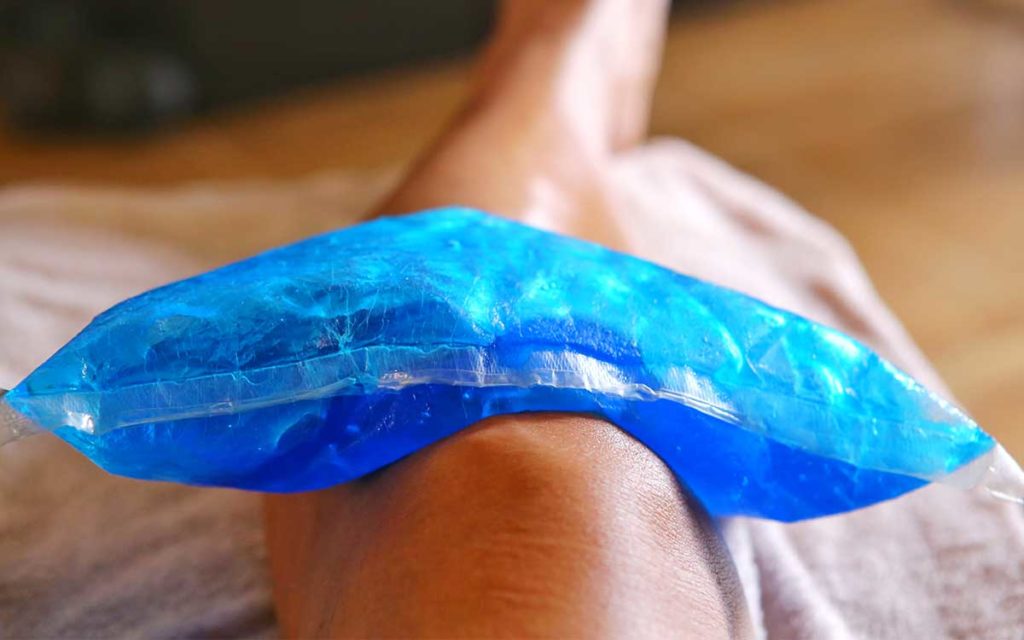If you plan to schedule or have already scheduled your procedure, it’s essential to know what to expect after knee replacement surgery so that you can have the best possible outcome.
With some preparation and good communication with your surgeon, you should have all the knowledge you need for a full recovery.
In this blog article, we’ll cover what recovery looks like at different points in time, help you prepare your home ahead of time with durable medical equipment, and give answers to the most commonly asked questions on the topic of what to expect after knee replacement surgery.
Timeline for Getting Back to “Normal” after Knee Replacement Surgery
Knowing what to expect after knee replacement surgery helps with your mindset and is paramount to recovery, according to John Lyon, MD, an IBJI orthopedic surgeon with fellowship training in adult reconstructive/joint replacement surgery.
“If you just tell people the truth, they appreciate it,” Dr. Lyon says. “They know that it’s true and they respect you because you’ve told them what to expect after knee replacement surgery.”
Your care team, led by your physician, will prepare you about the plan for surgery, including what anesthesia will be used, he adds.
One Hour After Surgery
What you’re experiencing one hour after your knee surgery largely depends on your type of anesthesia.
In regards to what to expect after knee replacement surgery during the immediate hour following your procedure, Dr. Lyon says, “If optimally performed under spinal anesthesia with what’s called a regional nerve block and preemptive perioperative and intraoperative pain medication, one hour after surgery, the pain should be mild to moderate at most, but very well controlled.”
“You may still be in the recovery room at that point. A recovery room nurse will deliver medications necessary for pain control, ideally applying ice and elevating the knee to reduce swelling.”
One Week After Surgery
Since most patients are discharged on the day of surgery, you can expect to be at home one week after surgery. Most likely, you are capable of walking after knee replacement with a walker or cane.
When considering pain among what to expect after knee replacement surgery, you may experience moderate pain (when you’re not performing knee exercises) to possible severe pain when performing knee range-of-motion exercises.
You would be applying cold therapy to your knee either with ice or some sort of ice delivery device. You would be compressing the knee at the surgical site with gentle compression, either with a bandage or compression-type stocking.
One surprising “what to expect after knee replacement surgery” fact is that you should be able to negotiate the stairs in your home just one week after surgery. You should also be able to get in and out of bed independently and walk outdoors.
One caveat: It will take longer to do your normal activities. What to expect after knee replacement surgery can include developing more patience when you:
- Take a Shower
- Get Dressed
- Prepare Simple Meals
- Move From a Seated or Lying Position to a Standing Position
Swelling
Patients will develop swelling in the leg, and there may be some bruising or redness around the incision area one week after surgery.
“These are normal findings,” Dr. Lyon assures. “There might be slight drainage from the incision, but resolving.”
Pain and Disrupted Sleep
At one week, you may not sleep well and have a disrupted REM sleep cycle due to pain after knee replacement. This is one of my patients’ biggest surprises when considering what to expect after knee replacement surgery. However, this is part of the healing process and will resolve over time.
“During the day, they should expect that their pain should be reasonably controlled when they’re not performing the knee stretching exercises,” Dr. Lyon says.
“At night, when one goes to sleep after a knee replacement, everything is quiet. You turn off the lights, and your knee starts talking to you. It says, ‘Hello, did you forget about me?’ It is the loudest voice in the room. It interrupts the normal sleep cycle.”
Therefore, naps during the day are part of what to expect after knee replacement surgery. “It’s okay to feel wiped out and tired as well as pushing yourself into pain to do your exercises,” Dr. Lyon says. “It will resolve with the healing of the knee.”
One Month After Surgery
The interruption of your sleep pattern will likely continue. But, the good news is that the incision is maturing, so you shouldn’t see any drainage at the one-month mark.
The leg swelling may persist, but you should get out into the community. Among what to expect after knee replacement surgery is the need to have a little assistance when venturing out of your neighborhood.
“A small percentage of patients will be driving at this time, but most won’t be,” Dr. Lyon says. “You will need to rely on someone to drive you.”
Returning to Work
Individuals who work at a desk may be able to return to part-time work at one-month post-op. If you perform manual labor or who need to be on your feet for your job, you won’t be able to return to work just yet.
Physical Therapy
Most orthopedic surgeons will send their patients to physical therapy for six weeks, so you may still be attending sessions one month after surgery. You should still expect to use ice and pain medication and transition off any narcotic medication that may still be in use.
Three Months After Surgery
Here’s what to expect after knee replacement surgery at the three-month mark:
- You notice that your recovering knee is much warmer to the touch than your other knee. This is normal.
- You may still be experiencing some minor stiffness in your knee.
- You may have some aching or swelling in your knee, especially after sitting for long periods or upon waking.
- You should be able to walk without a cane or walker.
- Your sleeping pattern should be back to normal.
- You can return to work, regardless of the type of vocation you have (sitting vs. standing).
- You can start exercising again.
“At this point, patients are performing exercises, but they’re not in physical therapy anymore,” Dr. Lyon says. “They are transitioning to more fitness-type exercises.”
When considering what to expect after knee replacement surgery, this is the part of the timeline where patients can start to ride a bicycle outdoors or use a stationary bike with low resistance.
Climbing Stairs
As you gain confidence with stair climbing, you’ll still want to continue to use caution when descending stairs. Dr. Lyon recommends the “two-step gait.”
“One foot goes down, and the next foot goes to the same step,” he says. “Most patients will still want to utilize a railing as they walk down. However, ascending stairs should be near to normal.”
One Year After Surgery
Many patients wonder what to expect after knee replacement surgery at the one-year mark. It seems like a lifetime away, but this is the long-awaited phase for most patients.
“You should be fully recovered at one year from a function standpoint, range of motion standpoint, and pain standpoint,” Dr. Lyon says. You may notice that the skin outside of the incision has some numbness. This is entirely normal and anticipated.
Here’s why: “There are tiny nerves that travel through the skin, and when the incision is made, because you’re breaking the skin, you’re also cutting through those nerves,” Dr. Lyon explains. “The area of the numbness is always on the outer side of the incision. That area of numbness will decrease in size but won’t return to full sensation.”
New Sounds
You may feel or hear clicking in the knee. Painless clicking is typical and what to expect after knee replacement surgery.
“It’s because the replaced knee has metal and plastic surfaces that will normally separate and recontact each other during normal movement and function,” Dr. Lyon says.
Kneeling and Squatting
Expect that the knee will be uncomfortable with certain positions or actions. Here’s what may feel a little different:
- Deep Knee Bends or Squats
- Kneeling, Which Is Possible But Uncomfortable
- Transitioning From a Kneeling or Squatting Position (You May Need Your Arms for Support)
- Bending Down to the Level of Small Children
In addition, your knee may still be slightly warm to the touch as compared to the other knee, and studies have shown that the warmth may persist up to one and a half years after surgery.
Preparing Your Home for Knee Replacement Recovery
At IBJI, your care team will support you with a packet of information that details what you’ll need at home for a successful recovery.
It’s vital to secure these items—also known as durable medical equipment—ahead of your surgery to avoid anxiety and remove the burden on family members to scramble post-surgery.
What Do I Need at Home After Knee Replacement?
Here are some of the must-haves after knee surgery (plus nice-to-have items, too):
- Adjustable Cane
- Walker
- Raised Toilet Seat (Preferably With Armrests)
- Shower Seat or Shower Chair
- Long-Handled Shoe Horn
- Sock Donner
- Long-Handled Graspers/Reachers
“I have a whole sheet that I give patients that lists all of these things from ‘strongly suggested’ to ‘as desired’ items,” Dr. Lyon says. “The key is getting these things set up before the surgery.”
Another thing to remember regarding what to expect after knee replacement surgery is that you will have to ice your operative knee.
To do so, you’ll need plenty of ice on hand, so put a bag into your freezer, invest in over-the-counter cool gel packs, or ensure your refrigerator’s ice machine is working properly before your procedure.
7 Things You Can Do to Speed Up Recovery After Knee Replacement Surgery

Now that you know what to expect after knee replacement surgery, here are some additional tips for a speedy recovery.
1. Follow All Physician Recommendations
Some patients think they can defer the preparation of getting medications ahead of time. They may think they don’t need specific durable medical equipment as recommended by their physician.
“You really need to listen to your specific physician and what they’re telling you because they know the techniques and how to get good results,” Dr. Lyon says. “Listen to the team and physician, and they’ll guide you. And, some of the best advice you’ll get is from people who have been through it before.”
2. Walk Frequently (Once You’re Allowed to Do So)
Patients should get up once an hour to walk. It’s essential to take rest breaks to elevate your leg, but keep walking and get outdoors when the weather is good.
3. Eat Healthy Food
Among your list of what to expect after knee replacement surgery, having an altered appetite is considered normal. This can last up to a week or two after having any surgery. However, it’s essential to focus on hydrating and eating a lot of protein, including eggs, milk, meat, and nuts which will help your recovery.
“Carbohydrates are appropriate too, but you must have the protein piece,” explains Dr. Lyon. “Stick to the basics, and not fast food.”
4. Get Plenty of Sleep
Be aware that sleeping isn’t going to be normal, but there are some things you can do to improve your rest.
“The knee is most comfortable when it’s slightly bent and elevated,” Dr. Lyon says. “Ice it before you sleep and make sure you’re taking some pain medication, preferably non-narcotic, before bed.”
If you have sleep apnea, you must have a functional CPAP machine. Visit with a sleep apnea medical team to ensure optimized use of the device.
5. Perform Recommended Exercises to Regain Range of Motion
You want to regain the arc of movement of the knee as recommended by the physician or therapist.
“The most successful patients are generally those that understand that they do the exercises and the therapists are their coaches, cheerleaders, and monitors for those exercises,” Dr. Lyon says. “Once the patients understand that, they will do well.”
6. Don’t Schedule Other Procedures Until After Your Recovery
There are some procedures you should have completed before your surgery, such as a colonoscopy or dental work. Any other procedures should ideally be delayed approximately three months after knee replacement surgery.
7. Don’t Put Unnecessary Stress on Your Knee
The goal is to focus on performing the exercises needed to regain range of motion first. After a surgery like this, the knee is tender enough only to handle a certain amount of stress in a day.
“As long as you get that range of motion, everything else will follow.” Dr. Lyon says. “Most range of motion is gained in the first six weeks after surgery.”
FAQs About What to Expect After Knee Replacement Surgery
Will I Have to Use Crutches After My Knee Replacement Procedure?
Therapists start most people out on walkers vs. crutches. Crutches tend to fall down and be less user-friendly. A walker is really only needed for a few days up to a week, and then people are onto a cane, primarily for safety and comfort.
How Long Does It Take to Walk Normally After Knee Replacement Surgery?
Most people walk in the community long distances and feel comfortable with that without a cane at six-plus weeks.
When Should You Have Surgery on Your Other Knee?
If you need to have your other knee replaced. In that case, you will want to have a conversation with your physician who will base the decision on a multitude of factors including:
- The Severity of Your Pain Caused by Arthritis in Your Non-Operated Knee
- The Course of the Recovery With the First (Newly Operative) Knee
- Your Medical Health Record
- Your General Physical Fitness Level
How Long Will My Pain Last After a Knee Replacement?
The most significant pain occurs while the knee is inflamed and recovering from the acute inflammation after the surgery. The first six weeks are the toughest. Of that six weeks, the first week is the hardest.
“What I like to tell people is that by six months, they should be 80% recovered from the standpoint of pain and discomfort,” Dr. Lyon says.
There will be ongoing symptoms of discomfort, including stiffness, aching, and swelling in the knee and leg after six months, but these symptoms, usually caused by sitting for a long time, should not require medication.
“If patients haven’t been educated accordingly, it’s not uncommon for them to think that something is going wrong,” Dr. Lyon says. “It takes about a year to a year and a half until all of the changes that have taken place resolve.”
What Are the Top Three Commonly Reported Problems After a Knee Replacement?
- Side Effects of Medication
- Drainage or Greater Than Expected Bleeding
- Swelling and Bruising at the Surgical Site
Side Effects of Medication
After you’ve been given anesthesia and pain medication, you may experience nausea, decreased appetite, stomach discomfort, and constipation. This is commonly what to expect after knee replacement surgery.
“The older you are, the more likely you will experience constipation, particularly when using narcotics and iron, which are frequently used to build up the blood count after surgery.”
Drainage or Greater Than Expected Bleeding
Drainage that comes from the knee incision is expected. Blood and serous fluid, which is a yellowish thick translucent-looking fluid (not pus), will drain for up to one and a half weeks after surgery.
Swelling and Bruising at the Surgical Site
Swelling and bruising at the surgical site is normal. Sometimes bruising will travel up or down the leg. Among what to expect after knee replacement surgery, you should know that blood thinners are often given to decrease the risk of blood clots.
This causes more bleeding at the surgical site resulting in increased swelling and bruising.
How Should I Sleep After Knee Surgery?
Sleeping in a bed is fine, but some patients choose to sleep in a recliner because this automatically puts their legs in a very comfortable position.
“If a patient lives in a multi-story residence, they sometimes choose to sleep in a comfortable recliner because they don’t feel comfortable climbing 15–20 stairs at bedtime,” Dr. Lyon says.
“You can go up and down stairs, but some patients don’t feel comfortable doing it right away after surgery.”
Can You Kneel on a Knee Replacement?
You can kneel, but you should defer to your specific surgeon’s advice about what to expect after knee replacement surgery and restrictions on how to use your new knee.
Because of tenderness, kneeling may cause discomfort. Knees after surgery don’t perform as well with deep knee flexion activities as they do with walking and standing, so getting down into a crouched position or on and off the floor can be awkward.
“If there are activities that patients enjoy and love, like gardening or prayer that require a knelt position, they will sometimes choose to do this despite the discomfort,” Dr. Lyon says.
“A knee pad on the floor is helpful to accommodate prolonged kneeling activities.”
Learn More About IBJI’s Knee Replacement Surgeons
If your knee pain affects your quality of life, look to IBJI’s highly trained surgeons and doctors who can discuss what to expect after knee replacement surgery.
IBJI offers convenient locations across the Chicagoland area, and we are experts in arthritis treatment, pain management, and total knee joint replacement surgery.
Get Connected with an IBJI Knee Specialist
Find a knee replacement doctor and when you’re ready, schedule online today.
You Might Also Like …
- How George Became Pain-Free After Robotic Knee Replacement
- Grateful Runner Thanks IBJI Doctor at Chicago Marathon
- Patient Story: Former U.S. Postal Worker No Longer Limps After Total Knee Arthroplasty
*This content is for information only and is not intended to replace the diagnosis, treatment, or medical advice from your treating healthcare professionals. The content does not provide medical advice, does not constitute the practice of medicine or other healthcare professional services, and does not create a doctor-patient relationship. You should not rely on this information as a substitute, nor does it replace professional medical advice, diagnosis, or treatment. If you have concerns or questions, seek the advice of your healthcare professionals. If you think you may have a medical emergency, call your doctor or 911 immediately. Do not rely on electronic communications or communicate through this website for immediate, urgent medical needs. This website is not designed to facilitate medical emergencies. The use of the information is at the reader’s own risk. The links are provided for information and convenience only. We cannot accept responsibility for the sites linked or the information found here. A link does not imply an endorsement of a site.




